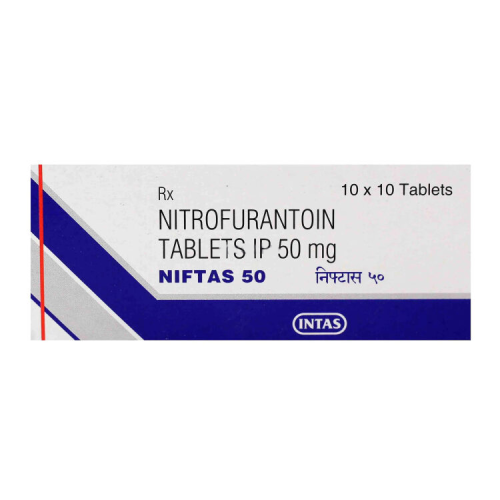Manufacturer: INTAS
Pharmaceutical name: Nitrofurantoin Monohydrate
Pack: 10 pills (50 mg)
Nitrofurantoin can act as either a bacteriostatic or bactericidal agent, based on its concentration and the susceptibility of the bacteria involved. It shows activity against several gram-positive bacteria, including S. aureus, S. epidermidis, S. saprophyticus, Enterococcus faecalis, S. agalactiae, group D streptococci, viridans streptococci, and Corynebacterium. When it comes to gram-negative bacteria, its efficacy extends to E. coli, Enterobacter, Neisseria, Salmonella, and Shigella. Nitrofurantoin might serve as an alternative to trimethoprim/sulfamethoxazole for treating urinary tract infections, though it could be less effective at eliminating vaginal bacteria. Additionally, it can be employed by women as a preventive measure against recurrent cystitis related to sexual activity. Nitrofurantoin is notably resistant to the development of bacterial resistance, which is believed to be due to its diverse mechanisms of action.
Niftas may also be considered as an alternative treatment for urinary tract infections and can be used by women pericoitally to prevent recurrent cystitis associated with sexual activity.
Niftas exhibits either bacteriostatic or bactericidal properties by disrupting the synthesis of DNA, RNA, proteins, and cell walls.
Niftas becomes activated by bacterial flavoproteins (nitrofuran reductase), leading to the formation of active reduced reactive intermediates. These intermediates are believed to interfere with and damage ribosomal proteins or other macromolecules, particularly DNA, thereby inhibiting DNA, RNA, protein, and cell wall synthesis. The ultimate result is the suppression of bacterial growth or cell death.
Niftas is efficiently absorbed in the gastrointestinal tract, mainly in the small intestine. Its absorption can be enhanced by food or delayed gastric emptying, fostering a more effective dissolution of the drug.
Acute toxicity may manifest as vomiting. Adverse effects may include nausea and discoloration of urine. Although rare, hepatotoxicity and hypersensitivity reactions have been reported. There is a risk of hemolytic anemia in patients with G6PD deficiency. Prolonged treatment or low creatinine clearance may lead to ascending polyneuropathy.

